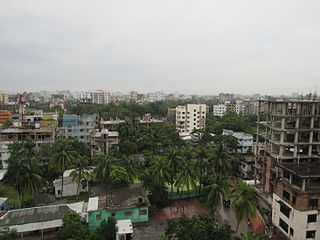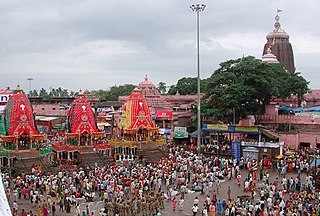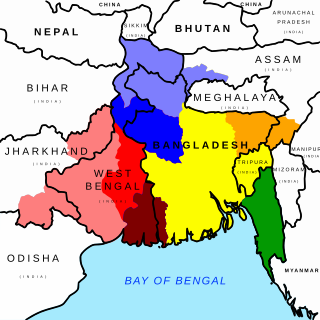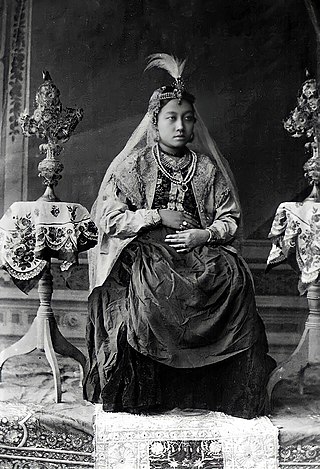
Agartala is the capital and the largest city of the Indian state of Tripura, situated on the banks of Haora/Saidra River, about 2 kilometres (1.2 mi) east of the border with Bangladesh and about 2,499 km (1,552 mi) from the national capital, New Delhi. According to 2022 AMC data, Agartala is the second most populous city after Guwahati in Northeast India. It is India's third international internet gateway and being developed under the Smart Cities Mission.

Jagannatha is a deity worshipped in regional Hindu traditions in India as part of a triad along with his (Krishna's) brother Balabhadra, and sister, Subhadra. Jagannath, within Odia Hinduism, is the supreme god, Purushottama, and the Para Brahman. To most Vaishnava Hindus, particularly the Krishnaites, Jagannath is a form of Krishna, sometimes as the avatar of Vishnu. To some Shaiva and Shakta Hindus, he is a symmetry-filled tantric form of Bhairava, a fierce manifestation of Shiva associated with annihilation.

Comilla District, officially known as Cumilla District, is a district located in southeastern Bangladesh. It lies about 100 kilometres south east of Dhaka. Comilla is bordered by Brahmanbaria and Narayanganj districts to the north, Noakhali and Feni districts to the south, Tripura state of India to the east and Munshiganj and Chandpur districts to the west.

Kantanagar Temple, commonly known as Kantaji Temple or Kantajew Temple at Kantanagar, is a Hindu temple in Dinajpur, Bangladesh. The Kantajew Temple is a religious edifice belonging to the 18th century. The temple belongs to the Hindu Kanta or Krishna and this is most popular with the Radha-Krishna devotees in Bengal. This temple is dedicated to Krishna and his wife Rukmini. Built by Maharaja Pran Nath, its construction started in 1704 CE and ended in the reign of his son Raja Ramnath in 1722 CE. It is an example of terracotta architecture in Bangladesh and once had nine spires, but all were destroyed in an earthquake that took place in 1897.

The Tripuri people (Kókborok: Tripuri dópha rok, are a Tibeto-Burman-speaking ethnic group of Bangladesh and Northeast Indian state of Tripura. They are the descendants of the inhabitants of the Twipra/Tripura Kingdom in North-East India and Bangladesh. The Tripuri people through the Manikya dynasty ruled the Kingdom of Tripura for over 600 years starting from 1400 A.D. until the kingdom joined the Indian Union on 15 October 1949. The Tipra Dynasty was established in 590 AD.

The Jagannath Temple is a Hindu temple dedicated to the god Jagannath, a form of Vishnu in Hinduism. It is located in Puri in the state of Odisha, situated on the eastern coast of India. As per temple records, King Indradyumna of Avanti built the main temple of Jagannath at Puri. The present temple was rebuilt from the tenth century onwards, on the site of the pre-existing temples in the compound, but not the main Jagannath temple, and begun by Anantavarman Chodaganga, the first king of the Eastern Ganga dynasty. Many of the temple rituals are based on Oddiyana Tantras which are the refined versions of Mahayana Tantras as well as Shabari Tantras which are evolved from Tantric Buddhism and tribal beliefs respectively. The local legends link the idols with aboriginal tribes and the daitapatis (servitors) claim to be descendants of the aboriginals. The temple is one of the 108 Abhimana Kshethram of the Vaishnavite tradition.

Tajhat Palace is a historic palace of Bangladesh, located in Tajhat, Rangpur. This palace now holds the Rangpur museum. Tajhat Palace is situated six km. south-east of the city of Rangpur, on the outskirts of town.
The Twipra Kingdom was one of the largest historical kingdoms of the Tripuri people in Northeast India.

The Puthia Temple Complex consists of a cluster of notable old Hindu temples in Puthia Upazila, Rajshahi District, Bangladesh. Located 23 km to the east of Rajshahi city, it has the largest number of historic temples in Bangladesh. The temples were built by Hindu Zamindars Rajas of the Puthia Raj family who were noted philanthropists of Rajshahi. The temples have been built in terracotta in a variety of styles combining the typical Jor-bangla architecture with other influences. The Rajbari or Palace of the Raja of Puthia and the Dol Mancha are part of the complex. The temples are laid out around a lake named Shyam Sagar and the complex is surrounded by a moat called Shiv Sagar.

Shree Govindajee Temple is a Meitei Hindu temple, dedicated to Hindu deities Radha Krishna (Govindaji). It is the largest Vaishnava temple in Imphal district of Manipur, India. It was originally built in 1846 during the reign of Maharaja Nara Singh and later rebuilt by Maharaja Chandrakriti in 1876.

Ratha Yatra, or chariot festival, is any public procession in a chariot. They are held annually during festivals in India, Nepal and Sri Lanka. The term also refers to the popular annual Ratha Yatra of Puri that involves a public procession with a chariot with deities Jagannath, Balabhadra, Subhadra and Sudarshana Chakra on a ratha, a wooden deula-shaped chariot.

Tripura State, also known as Hill Tipperah, was a princely state in India during the period of the British Raj and for some two years after the departure of the British. Its rulers belonged to the Manikya dynasty and until August 1947 the state was in a subsidiary alliance, from which it was released by the Indian Independence Act 1947. The state acceded to the newly independent Indian Union on 13 August 1947, and subsequently merged into the Indian Union in October 1949.

Maghoki Attori Mosque is a historical mosque in Bukhara, Uzbekistan. It forms a part of the historical religious complex of Lyab-i Hauz. The mosque is located in the historical center of Bukhara, about 300 meters southwest of Po-i-Kalyan, 100 meters southwest of the Toqi Telpak Furushon trading dome and 100 meters east of Lab-i Hauz. It is a part of UNESCO World Heritage Site Historic Centre of Bukhara. Today, the mosque is used as a carpet museum.

Mahilara Sarkar Math is an ancient Hindu temple and archaeological site located in the Barisal District of Bangladesh. It was built by a local influential man named Rupram Das Gupta during the reign of Alivardi Khan in the 18th century. The Shikhara-style monument is now protected by the Department of Archaeology and classified as an 'archaeological monument'.
Dharma Manikya I, also known as Dangar Fa, was the Maharaja of Tripura from 1431 to 1462. His reign was notable for its territorial expansions as well as for his religious and cultural contributions.
Ratna Manikya II was the Maharaja of Tripura from 1685 to 1693 and again from 1695 to 1712.

Rajdhar Manikya I, also spelt Rajadhara Manikya, was the Maharaja of Tripura from 1586 to 1600. Formerly a warrior-prince who fought with distinction during his father's reign, upon his own ascension to the throne, Rajdhar showed little interest in such matters, instead becoming occupied with religious pursuits. The decline of Tripura is thought to have begun during his reign.

Bengal temple architecture is about temple styles developed and used in Bengal, particularly the chala, ratna and dalan temples.
From 13 to 19 October 2021, Muslim mobs instigated communal violence against Hindu communities across Bangladesh during the Durga Puja festival, in response to a viral video where Quran was kept under a temple idol's feet. More than 50 temples and makeshift worship arrangements were vandalised all over Bangladesh.

The royal marriage alliances between the Meitei royal family, Ningthouja dynasty of Manipur kingdom and the Manikya dynasty of Tripura kingdom brought good relationship between the two states as well as assimilation of the two cultures. The Tripuri kings married not only the Meitei princesses but also many other ladies of commoners' families of Meitei community. Meitei queens were remembered for their contributions to the development of the Tripuri society. So, they were given high status in the royal house of Tripura.


















